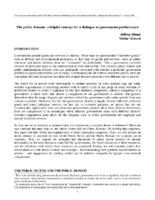Mostrar el registro sencillo del ítem
The public domain: a helpful concept for a dialogue on government performance
| dc.contributor.author | Rinne, Jeffrey James | |
| dc.contributor.author | Orozco, Victor | |
| dc.date.accessioned | 2018-09-02T06:07:43Z | |
| dc.date.available | 2018-09-02T06:07:43Z | |
| dc.date.issued | 2009-10 | |
| dc.identifier.uri | http://cladista.clad.org//handle/123456789/5670 | |
| dc.description.abstract | Policy makers and public administration scholars often are profoundly concerned with whether a particular government provides its goods and services well or badly. Unfortunately for all of these concerned parties, there are conceptual and data limitations that make this straight-forward question a very difficult one to answer. The search for an answer leads immediately to another question: by what standard may one judge whether a government is delivering services well or badly? Good or bad, large or small, efficient or inefficient relative to what? A judgment of this kind demands comparison -either a comparison of a government to itself over time and/or a comparison of one government to another. How are comparisons to be meaningful when different governments make such different choices? | |
| dc.description.abstract | Genuine comparisons must allow for the disparate ways in which governments are organized and operate to deliver services. The paper leans on the concepts of the Public Sector and Public Domain to construct a common basis for comparison and presents an initial attempt to calculate the size of the Public Sector and the Public Domain for a sample set of countries. It later explores the strengths and limitations of public sector statistics to present information on the total resources controlled by governments, the broad allocation of these resources, and the efficiency with which those resources are employed. | |
| dc.description.abstract | The authors conclude that, although serious data limitations remain to conduct robust comparative assessments, the value of greater conceptual rigor is twofold. First, the likelihood of making spurious claims about the government service delivery in one country or another once there is a full understanding of the differences in public sector terminology and a careful use of this vocabulary is lower. Second, even with the data limitations at hand, the concept of the Public Domain, when combined/contrasted with the Public Sector, adds to our understanding of the government service delivery, expands the range of questions we may ask and attempt to answer and helps to open a richer dialogue on public sector service delivery and government performance. | |
| dc.format.extent | 16 p. | |
| dc.language | Inglés | |
| dc.publisher | The World Bank | |
| dc.rights | Creative Commons BY-SA-NC 4.0 Int | |
| dc.rights.uri | http://creativecommons.org/licenses/by-nc-nd/4.0/ | |
| dc.subject | CONGRESO CLAD 14-2009 | |
| dc.subject | CALIDAD | |
| dc.subject | CALIDAD TOTAL | |
| dc.subject | SECTOR PUBLICO | |
| dc.subject | BIENES | |
| dc.subject | SERVICIOS PUBLICOS | |
| dc.subject | TEORIA DE LA ADMINISTRACION | |
| dc.title | The public domain: a helpful concept for a dialogue on government performance | |
| dc.type | article | |
| clad.congress | Congreso Internacional del CLAD sobre la Reforma del Estado y de la Administración Pública, 14 | |
| clad.key | MFN42427--42427 | |
| clad.key1 | KEY42427 | |
| clad.md5 | cda06035681d94a51aadb23b60cdcecb |


